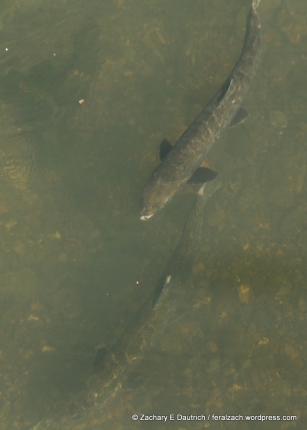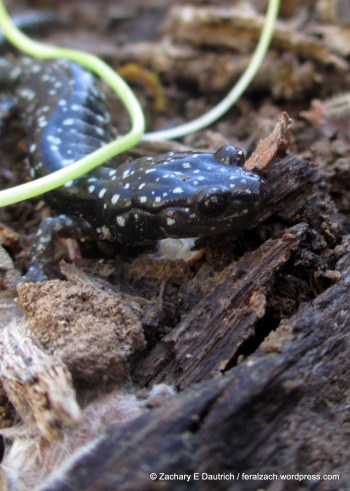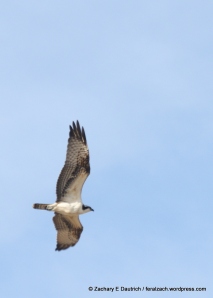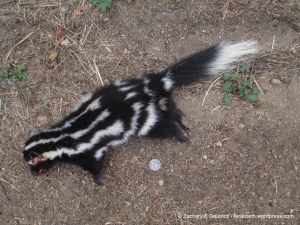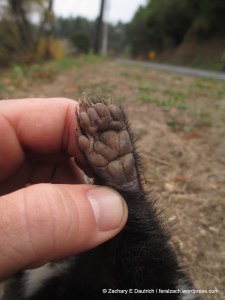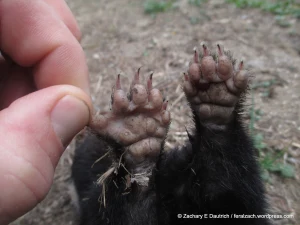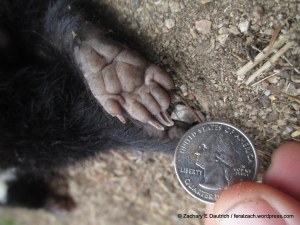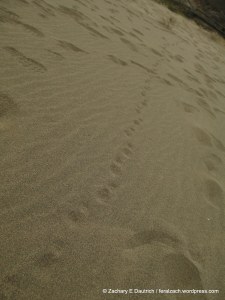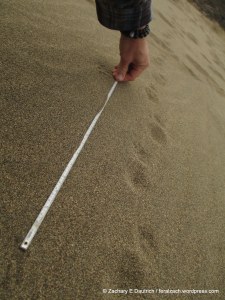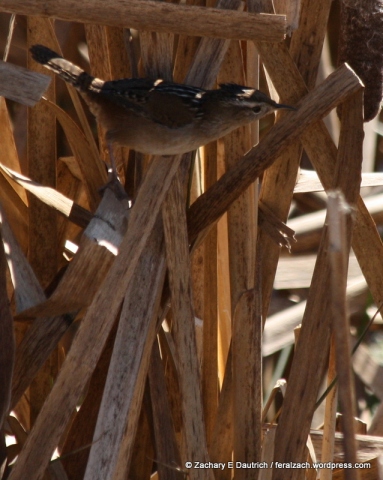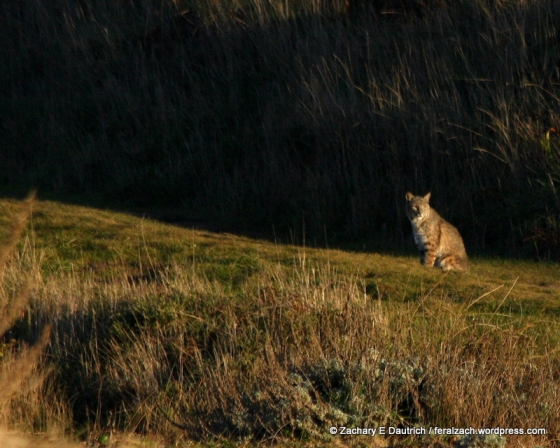canine track id study

the other week during a wander with my friend and mentor Jim Sullivan (see his website and tracking class offerings here) – an amazing tracker, naturalist, and all-around brilliant fella – and other great trackers like Ginger; we had a suburb opportunity to see some canine species’ track diversity laid out before us. it’s not often you get to see four canine species’ tracks together in decent substrate. identifying the differences between them can often be very challenging, so any chance to see any of their trails, also in varying substrates, is incredibly illuminating. to get to see all of them in one day avails an incredible study opportunity.
coyote vs red fox vs gray fox vs domestic dog – it is a study that is always ongoing for me, especially with partial tracks and trails. these species don’t always overlap geographically, and even if they do, often their seasonal movement patterns don’t overlap in such a way that you can see their tracks together, especially in one day. sometimes it is very obvious the difference, but sometimes it can be confusing given the right circumstances.
 gray fox track / Bodega Bay area Sonoma County CA
gray fox track / Bodega Bay area Sonoma County CA
 small red fox track (likely non-native species, on left) and western coyote track (right)
small red fox track (likely non-native species, on left) and western coyote track (right)
 red fox (R) and western coyote track (L) / track plates copyright Mark Elbrock’s book
red fox (R) and western coyote track (L) / track plates copyright Mark Elbrock’s book
the red fox tracks we found were on the small end of the spectrum – there was some debate about id due to the size. it was at the small end of the red fox size spectrum (and at the large end of the spectrum for gray fox), especially upon initial (eye-ball) inspection. but further analysis (and healthy, civil debate among accomplished trackers) left us concluding red fox. context, the full trail, and multiple tracks often help in track id. actually it’s often about context. having the chance to see full trails, and the way the tracks vary within each substrate, really help in honing the ability to discern one species from the other in the future when there is only a partial track or trail.
 a snippet from my journal analysis of red fox vs coyote 2015
a snippet from my journal analysis of red fox vs coyote 2015
drawing and journaling is a great way to solidify the memory of ideas and patterns in the ol’ brain.
great day
chasing mountain lions blog to resume soon …
I’m excited to report that I am helping with a new puma project in the Bay Area, my other blog chasing mountain lions will be updated with a new chapter soon …
Here are pictures of tracks of two of the cats that we are tracking and trying to capture right now in the mountains East of San Jose near Mount Hamilton:
And here are a few of the residents where we are tracking the lions for capture (to outfit them with GPS collars) …
More to come soon …
trailin’ hogs!
I had the good fortune to go for an adventure yesterday with a friend to practice trailing animals – the species of focus was the feral pig (feral hog).
The weather was outstanding, despite some strong winds early in the day. It doesn’t get much nicer here than these sunny days with clear blue skies and temps in the 70’s – and the light was great too. I knew it was going to be a good day when not long after sunrise I saw a juvenile bald eagle (hatch year / 1st year) perched in a tree overlooking a creek. It was eyeing up some water fowl and steelhead, the latter of which were spawning in the creek bed below.
[juvenile bald eagle]
Steelhead are a type of salmon, and once were found in great numbers up and down the west coast. As with many of the salmon, their populations have been suffering due to over-fishing, habitat loss, and pollution. This time of year, mature fish swim from the ocean back into small creeks and streams from where they were born, where they create nests in the creek beds to lay their eggs. Unlike other salmon who die after spawing, some steelhead return to the ocean for another go. Interestingly, according to current science taxonomy, they are the same species as rainbow trout – the difference being that steelhead are anadromous, meaning they spend part of their life in the ocean. Because of this, they look physically different than fresh water rainbow trout (larger). These fish shown below were probably close to three feet long!
[steelhead]
I was on my way to a remote area of western Sonoma County where we were going to do our wander, on some land miles from any roads by the Gualala River. I feel like Sonoma County is my “second childhood home” – and it felt so good to be visiting on this beautiful spring day.
When driving along a ridge line with views going miles in all directions, the land looks like a piece of bunched up fabric – deep, drastic valleys at the bottom of steep descents that fall from high mountain tops and ridge lines. Huge stands of douglas fir and redwood are on many of the north-facing slopes, with oak woodland spanning other parts of the more sunny areas. Some of the land remains ranch land, and many folks have made their living with sheep and cattle out here. “As the crow flies,” the distance between two points seems not too far – but when traveling on land, it can take a long time to travel a short distance. And there’s seldom a direct route. Perhaps it is this ruggedness that has helped keep it somewhat intact – it isn’t conducive to the industries of man. May it remain as such!*
Feral pigs, also called feral hogs, are non-native animals whose relatives escaped from the domestic life and have secured a place for themselves and their progeny in the wild. Sonoma County has a large population of them, and many areas of the country consider them to be a pest. They certainly don’t tread lightly on a landscape – in areas of high density, the ground can be torn up all over the place from their rooting. They are an amazing animal – highly intelligent, very social, and incredibly adaptable. They can also get pretty big – some of the larger boars are around 300 pounds! And they can be pretty intimidating to see – large tusks, coarse hair covering parts of their body – they often don’t look like their barn-yard cousins.
I have mixed feelings about the native / non-native debate. The truth is that many of our ecosystems are so different than they were prior to European colonization – especially with the removal of so many of the apex predators – that it is unlikely they will ever be the same. Especially without reintroduction of the trees, plants and animals that were originally here and created a balanced web of life. You don’t grow old-growth redwood trees overnight. I imagine the pigs would not be as successful if there were wolves and grizzly bears around (as there once were in this area) – but I bet the main detractors of the hogs would be even less apt to welcome that strategy!
There is a difference for humans, psychologically, when labeling an animal as a pest and/or a non-native – somehow it’s life seems to be valued less. I have an issue with this. These are still living, breathing creatures, just doing what we all are doing here – trying to make a living. I’m not suggesting that all non-native animals should just run amok with no management plan in place, but I do believe there can be better, more compassionate management strategies that are also more supported by science. Ones that honor these animals as individual living beings, with a value the same as any other living being. Sadly, humans have used (and continue to use) this type of labeling to denigrate people too – whole cultures, races, and people of varying lifestyles have been subjected to horrible treatment because of this manipulative psychology of labeling.
+++++++
It was fun to get to be in the world of the hogs for the morning! We started off by looking for some fresh tracks so that we could have a chance at being able to trail and find the animal that laid them. The pig sign was everywhere – the trick was finding something fresh. Despite some of the recent rains, the ground in some areas was already becoming quite dry again, so it wasn’t holding sign as well as it had been just a week ago.
[some fairly fresh hog tracks]
We ended up on several different hog trails, the first of which took us down a steep hill side, traversing downward through the trees. We saw quite a few pig beds – all empty – strategically situated at the base of large trees on a steep slope, with crunchy leaves all around that would belie the presence of an approaching predator (or tracker!) and allow for multiple escape routes. After being on it for quite a distance, eventually we lost the trail – which seemed impossible, given we were following a number of individuals travelling together. How do 150 to 300 pound animals seem to vanish and leave no discernible sign? Perhaps there is a “pig vortex,” similar to the “raptor vortex” – the place raptors seem to often disappear to, out of the air, when you take your eye off them for a second! Amazing! Humbling.
We continued on, looking for another trail to follow, and eventually we found some more fresh sign just off the dirt access road we were following. After poking around a bit, we took a hog trail down another steep slope descending 100’s of vertical feet. There were some fairly fresh tracks on it, but mostly we were just curious where they were going as it seemed to be a highly used trail. It took us all the way down to the bottom of the valley – and to the Gualala River.
I could have spent days at that spot. The river was gently flowing past, its gray-green waters moving over small round river stones on its bed. Small waterfalls and seeps were cascading into the river from the steep hillsides, scouring the rocks and making a home for glowing moss and lichens. An abundance of life, and signs of animals passing through, was everywhere. I was overwhelmed by the calm and beauty.
I finally couldn’t resist and waded into the water (it was also the easier route around some poison oak that was guarding a narrow pass on the steep banks!), and saw a couple of newts hanging out under the surface of the chilly water …
[red-bellied newt (Taricha rivularis)]
[rough-skinned newt (Taricha granulosa granulosa)]
Once I made my way back to shore, we saw a little snake sunning itself on a rock ledge. All the animals seemed to be in the same blissful, relaxed state that I was in … under the spell of the Gualala River and the warm sun above.
[CA red-sided garter snake (Thamnophis sirtalis infernalis)]
Finally, we hit upon some nice fresh hog tracks in the soft sediment on the banks of the river. Back on it!
These were likely from a pretty big boar. We followed him back up the hillside from where we came, but once again after a little while we lost the trail. Humbling! As we fanned out and attempted to pick it back up again, we found another little creature on the hillside under a log that we had disturbed.
[juvenile speckled black salamander? (Aneides flavipunctatus flavipunctatus)]
We put a new rock and some leaves back over this young lady to keep her out of the sun after we left.
[some type of lily? anyone?]
[UPDATE – Fritillaria affinis aka the chocolate lily or checkered lily
edible bulb/roots
thank you Ann for the ID!]
As we got to the top of the hill, we found the boar tracks again … and it was one of the tracks that we had originally seen when we started on this trail! We had come full circle.
We reluctantly made our way out of the property, but as we were leaving we spotted one last treat – a golden eagle! it was a double eagle day. A good sign and a perfect ending to a great morning.
I am so thankful to have gotten to spend the day out there, many thanks to my friend Matt for taking time to share this special place with me.
+++++++
* As a side-note, in recent times vineyard owners have been trying to push into some of these areas because they are ideal for certain grape varietals, such as the popular pinot noir. Thankfully there are many organizations, including Native groups, that are spearheading the effort to keep this land intact from groups who want to convert forest to vineyards (or other clear-cutting). The amount of life that is impacted by deforestation is astounding, and humans have already destroyed 96% – NINETY SIX PERCENT – of existing redwood ecosystems since the west was “settled” … and old growth constitutes just a small part of that which remains. Scientists have barely scratched the surface of understanding ecology and the web of life on this planet, and it has been shown that the canopies of redwood forests contain a huge amount of biodiversity. Seems like there is a lot of value in honoring these remaining places – and perhaps a duty to do so.
another adventure at the lagoon
Sunday was a warm and clear day on the coast, strange weather for January – it felt like summer (well, summer anywhere besides the coast and the Bay area). We started the day by witnessing some interesting behavior by a couple of deer that caught our attention. The deer, which appeared to be doe and a yearling (nearly the same size), were standing with heads raised and their focus on something in the chaparral to the north of us. The yearling took off trotting, then bounding, right towards the path we were on, seemingly unconcerned with our presence. It then stopped and turned around, bounding back to its mother. The two of them then started a slow walk in the direction of the threat, with the mother in the lead. Shifting our position back down the trail, we were able to see what was causing the concern …
I was only able to catch the tail-end of the bobcat as he disappeared into a coyote bush (for the moment now a bobcat bush) – a large male that uses this particular territory who’ve we’ve tracked and seen around here before. Although I think it’s rare for bobcats to take down full grown deer in this area, fawns are fair game. This particular young one is probably big enough to be safe, but given the respect that the deer on this day showed towards him, and on another occasion when I witnessed his presence disturb them, I’d say he is still viewed as a threat. He seems to be a large bobcat based on his tracks and scat.
The most interesting part of this whole interaction was when the deer started to FOLLOW the bobcat – the doe literally walked right to where the cat had disappeared, and she seemed to be chasing HIM out of the area! Good stuff.
On the way in to the lagoons, I spotted an American bittern in a small pond along the pathway – I’ve seen one on the far shores of the larger lagoon, but never one so out in the open here. It was shaping up to be another good day, with lots of live animal sightings. Later in the day on the return trip it was still there and posed for some pictures in the beautiful light.
As we approached the lagoon, a resident great-blue heron was hunting in the shallows.
There were quite a few sets of trails and tracks on the dunes, but the striped skunks were most prevalent. This is their mating season, during which they really seem to be wandering around outside of their normal areas with higher frequency – sadly it is also marked by the large number of road kill skunks at this time of year. Notably absent was the female bobcat that usually patrols this area. It is also breeding season for the cats, so her daily patterns are likely interrupted by the breeding impulse. I also spotted at least one golden eagle soaring above the hills, only the second time I’ve seen one in this particular area. Along with a ferruginous hawk sighting (a somewhat rare winter visitor in this area) and the great view of an intermediate morph red-tailed hawk, we had some great raptor and other bird sightings. During the day at various times the family of otters was visible on the upper lagoon, but I never really was close enough for any pictures. Just their presence is a joy, watching them even from afar is so fun.
As we were resting by the lagoon, a pie-billed grebe made it’s way out of the shallows by the cattails with quite a prize – after straining to identify what it was, we realized it was a small bass! The grebe paddled around with the fish in its beak for at least five minutes, occasionally shaking it and twice losing it in the water, but diving down and quickly recapturing it. Finally, after almost ten minutes, it downed the fish whole!!
Impressive.
Another great day out there, I’m so thankful for that place and to be able to wander in it. Thanks also to Richard Vacha and everyone who participated in this Marin Tracking Club excursion for making it a fun and educational day.
another abbott’s adventure … sand stories
i don’t have a lot of words right now. one morning at a place like this is the same as reading 1000 books, combined with touching 1000 textures, smelling 1000 smells, hearing 1000 sounds, tasting 1000 flavors, seeing 1000 treasures and feeling a 1000000 heart strings of life.
we were treated at the beginning of the morning just after sunrise to the five resident Otters foraging in the lagoon, and a visitor that I have never seen before in this immediate area … a golden Eagle!
the above picture was of a creature foreshadowing things to come – this red-legged Frog (?) was a precursor to SO many Frog tracks in the sand, along with many deer Mice and brush Rabbit tracks – appearing in the middle of bare sand dunes for reasons unexplained. I surmise the new moon allowed some expanded forays for these normally reclusive species who stick to the cover of the plants on the edges of the dunes during most times.
brush Rabbit tracks
Frog tracks (likely red-legged Frog)
river Otter scent marking on the dunes
Bobcat (on right) and some type of amphibian (Salamander) tracks on left – perhaps an Ensinitas?
deer Mouse tracks with tail drag
beautiful clear front tracks of a red-legged Frog (right) along with deer Mouse tracks on the left
great-horned Owl tracks leading into a take-off spot
great-horned Owl trail …
WOW! what a find!!!! the trail seen in the picture from the left is a great-horned Owl coming in for a landing (final landing spot seen in the center of the picture). you can see it’s wing and tail feather imprints in the sand. also you can see a Raccoon trail diagonally across the picture from lower right to left (occurring after the Owl), along with faint Frog tracks paralleling the Raccoon, and some two-legged tracks at the top.
another view of the great-horned Owl landing spot (along with feather marks in sand!!), and its trail leading away from the landing point – ultimately to a take-off spot around 10 yards away. again, you can see the Raccoon trail across the center, and many other tracks in the background.
great-horned Owl tracks
a beautiful black-tailed mule Deer trail
Sanderling trail (?) … though I’m open to other interpretations … and some faint deer Mice, Frog and insect trails – this was found in the lagoon sand dunes, far from the surf
more Sanderling (?) tracks
another (!) great-horned Owl trail in the sand dunes!
one of my favorites to see live (but seldom a dependable sight), there were plenty of north american river Otter tracks around
the turkey Vultures are always hanging around for a meal, and this (faint) track (among smaller shore bird tracks) showed that they are quick to come in on the remains of shore birds who are predated at the lagoon by a varied cast of opportunists …
Bobcat tracks in sediment / algae
Bobcat trail in sediment / algae
Bobcat tracks (nice shot of front and rear) – based on the size and the shape, we decided it was likely a male
likely a Bobcat scat – it contained almost purely feathers!
Osprey – one of the NINE raptor species that we were treated to seeing on this day (Osprey, northern Harrier, white-tailed Kite, Kestrel, peregrine Falcon, turkey Vulture, Red-tailed hawk, Ferruginous hawk, and golden Eagle!). My friends also saw a Cooper’s hawk as they were driving out.
Red-tailed hawk on dunes
these snowy Plovers, a highly endangered species, were using human tracks in the sand as wind breaks from the increasing gusts coming in from the ocean – it was pretty adorable
this peregrine Falcon was not welcome company for the Kestrel who was attempting to escort it out of the area
the “mud hen,” or Coot – top of the menu for many predators at this time of year here. when the Otters come by, they move to the shore and band together, waiting for them to pass
for reasons still not understood (by me), the Ravens were harassing the Red-tailed hawks as usual. perhaps it is for fun or to prove social status … fun, being something that the Ravens seem to incorporate into their lives all the time, evidenced by their frolicking in the air lifts caused by the oncoming winds into the dunes. seeing them play in the air is like watching Otters in the water, the energy is simply fun!
lots of black-tailed mule Deer around in the fields, where we also saw lots of Badger sign
Coyote tracks
a cool shot of some black-tailed mule Deer tracks in the sand (with some two different bird tracks on the right of the frame)
the only animal signs that I might have expected to see and didn’t on this day were the grey fox and jack rabbit. grey Fox sign isn’t often seen right in this area, but jack Rabbit is. curious.
what a great day out at Point Reyes National Seashore, this place is such a gift – may it be protected for all this diversity of life to thrive, always.
zd
teaser
There are too many photos and stories from yesterday to rush this tale, which I don’t have time at the moment to honor properly – but here are a few teaser photos until I do. Honestly, books could be written about what is found in any few square feet of space in places like Abbott’s Lagoon. The richness and density and variety of life in this area, along with many friendly substrates that record so much of it to see afterward, is just such a gift.
The above picture is of a Great-Horned Owl landing spot in sand – you can see where it landed, and in the foreground is the imprint of its wing feathers in the sand. You can also see the trail of it walking away, out of the frame to the top left of the picture … a trail of about 15 feet, where it took to the air again.
Black-Tailed Mule Deer Buck
Ferruginous Hawk
Bobcat tracks in algae/sediment
western spotted skunk
The rare spotted skunk made itself know a number of times one day a few weeks ago out at Point Reyes National Seashore … sadly one of them was road kill. But, it offered a chance to really check out it’s feet (which, consequently, I paid for by having a smelly hand for three days). They are smaller than the striped skunk, but equally as smelly. Very cute though.
otters and deer and other Point Reyes fun!
Any day spent in Point Reyes National Seashore is a gift, and the fact that this land is preserved is quite a gift unto itself – and a testament to the forethought and sensibility of some of our forefathers. I am so very grateful for places like this.
On this particular day, I joined several other trackers/naturalists to do some study on the landscape. As always, we saw a lot of fun things, some real-time and some emblazoned in the stories told by the traces and tracks left on the land.
As we explored the tracks and sign along the trail on our way out to the lagoons, we encountered some of the residents for which we usually only see their sign … river otters! As I mentioned in an earlier post, any day with otters is a good day, as far as I’m concerned. Unless they’re chewing my tires or something (thankfully, this has not happened to date). Everything they do seems to be fun. Probably anthropomorphic, but c’mon! There is a fun vibe to many of their antics. Don’t deny it any of you rigid science folk!! Of which I am one, so easy now.
After a great morning of tracking and learning, the group split up – I stayed out and saw lots of brush rabbit, mice and deer sign in the maze of trails in the dune grasses as I explored. Once I made my way out onto the beach, the waves were BIG but much of the sand slate was washed clean of tracks from the last tide. Still, there were some coyote trails along the dune grass / beach interface, and a lot more brush rabbit and plover(?) sign as well. I didn’t see one skunk track the entire time – interesting, because a month ago the dunes were covered with skunk trails (see my January post here).
At one point, I ended up stalking two deer on top of a bare hilltop above the dunes. I had seen the deer an hour previous, as I wandered below under their watchful eye, and was surprised to still find them there when I inadvertently found myself by them on the hill top. As a general rule I make a hefty effort to be unseen to any wildlife that I observe or photograph. But sometimes, as with the case with deer who are somewhat accustomed to seeing people in their areas, I’ll have some respectful fun. In addition to being just really fun to attempt to get close to them, it was a revealing close-up look at how they sense threats and movement. At one point I was about 10 or 15 feet from the younger of the two deer – after stalking within 20-25 feet, they got comfortable and actually moved towards me.
“Hey, was that flannel shirt, with a human in it, laying there on the ground this whole time?”
(five minute pause and stare)
“Uhh, I guess so I don’t know – look at this yummy grass though! It hasn’t moved so let’s keep eating.”
(munch munch)
They kept browsing for a long while, and I was so close I could hear them chewing, with the backdrop of crashing waves for a bass line. Finally after a period of time the adult female laid down with her back to me, surveying the dunes below her, so I rolled down the backside of the hill (literally – a fun exit strategy!) and let them be (resisting the temptation to get closer – ooo, to touch one! someday …). Interestingly, during the whole experience they seemed most alarmed by my backpack as they approached me, which was sitting 30 feet behind me and sitting upright as I crawled on the ground. They were very curious about me and the backpack, but after a period of evaluation, from a close distance, they seemed to discount me as either a threat or anything other than a rock or leftover human gear.
I’ve also experienced that same sentiment in the past from girls at a bar, interestingly.
A great day out at Point Reyes.
Special thanks to John Brossard for facilitating a great morning – check out some of his classes at this link.
Point Reyes tracking day
Ahh, where to begin. This post has taken me a long time to get up because one day of tracking can yield volumes of stories and tales!
Our day at Abbott’s Lagoon a few weeks ago began with a morning of warm sunshine, after a few days of very cold temperatures and rain – as we started out towards the sand dunes near the beach we saw quite a few black-tailed mule deer in groups of over ten individuals. There was a herd of males of all different ages in an adjacent field, their antlers varying from sprouts to full racks. They seemed to be frolicking in the warm sun, play sparring and hopping around each other like fawns on a beautiful spring day. What really caught our eyes though was another group of deer to our north … one of them was standing guard to the west and not even our presence took this doe’s attention off something towards the eastern lagoon. Her behavior queued us in to another presence that warranted her attention more than humans. It had to be a predator.
As her group grazed, she seemed to be doing some tracking of her own. We decided to see what it was that garnered such focused attention, and we moved quietly across the chaparral to investigate. As we moved west, the look-out deer finally broke her sentry post and they all moved on to the east. We didn’t see what had attracted her attention, so we started to investigate the area where the deer were grazing to see what was for breakfast. As we moved west through the brush though, our efforts were rewarded as the hard ground gave way to add a character to the story by yielding a single clue … a fresh bobcat track in some soil upturned by a gopher!
We were able to trail it for a distance, the fresh tracks sometimes not visible at all, occasionally popping out for us to see in some loose soil after losing the trail for 20 feet at a time. With great reluctance after trailing the cat for 500 yards, we abandoned our search to see the maker of the tracks to continue on our journey towards the dunes. I would be rewarded later though …
Once at the sand dunes, we saw an explosion of activity that indicated many animals were eager to be out after so many days of cold and/or rain. Another bobcat made some nice trails, along with black-tailed mule deer, river otters, coyotes, gray fox, great-blue herons, ravens, deer mice, beetles, brush rabbits, skunks, opossum, raccoon, and more. There was a lot of skunk sign, and we postulated that they were very active after a short period of torpor (similar to hibernation) that left them hungry and in search of mates. Deer mouse sign was also everywhere, their small tracks making trails all over the dunes.
The evidence of another saga soon played out on the sand dunes before me – a bobcat trail that showed what I determined to be a recently captured brush rabbit. The trail had drag marks that extended under the cat for 30 yards to a spot where it did tight circles as it either made the final kill or adjusted the prey in its jaws, then sat for a bit. The trail went on then for 20 yards up into some dune grasses where there were bits of rabbit fur and presumably the cat ate its meal.
This particular area usually is thick with coyote sign, and seldom have we seen gray fox sign here – but this day showed evidence of at least one fox that had traveled with purpose around the whole area. The tracks are dainty next to the many coyote tracks, and I was excited to see find the trail.
I trailed one of them for half a mile down the beach, its tracks following the vegetation line at the edge of the beach, at one point going down into the surf area where the water washed away its paw prints at the last high tide before it veered back up to continue on its journey north towards Kehoe Beach (where their sign is much more prevalent according to others familiar with the area). It was a very purposeful gait, seldom stopping to investigate the ocean flotsam along the shore. What spurred this fox on an unhurried yet purposeful journey on the beach? The search for a mate? A territorial scouting mission? Food? It will be interesting to see if there is more sign in the future or if the foxes will remain more north towards Kehoe beach after this.
At one point as I backtracked one of the bobcats, I was excited to catch sight of an American bittern hunting in the floating vegetation on the edge of the east lagoon. Among the live animals I saw this day were great-blue herons, ravens, gulls, two snowy plovers (a very endangered species), red-tailed hawks, white-tailed kites, northern harriers, turkey vultures, yellow-rumped warblers, black-tailed mule deer, a peregrine falcon and …
… a bobcat!
Good stuff.
The dunes are ever-shifting, they can be an amazing palette for animal tracks or the tracks of the wind, giving a brief glimpse at the stories played out in the hours before. But the winds eventually wipe the slate clean like words fading on a page, as the dunes make their own tracks across the landscape.
a bald and white Christmas in PA
Yes, Christmas will always be bald and white for me with regard to one definition of those terms at this point in my life, but this particular Christmas we were treated to other, more fun benefactors of those descriptors – a snowy Christmas eve yielded a white Christmas morning, and we got quite a show by some local nesting bald eagles.
These are presumably the same birds that have been nesting at this site for the past few years not far from my parent’s house in PA (see my post from last year here). It’s great to see them still successfully using this nest as it is more exposed and closer to human activity than most nests. This is actually a GOOD thing, as it indicates that most of the other more ideal nesting spots and territories around the Susquehanna River are already taken by breeding pairs.
The snow also allowed us to see who was using the landscape … snow tracks! It’s far from wilderness here, but this beautiful agricultural area still has quite a bit of wildlife that manages to survive in an area that continues to have more and more human development replace farms and forests. We were still able to find the tracks in the nearly melted snow of white-tailed deer, cottontail rabbit, and two red fox – and ultimately I was able to find what I think is the red fox den! A couple of red-tailed hawks were hunting in the cold air above us, and we spooked a coopers hawk with a meal from its perch in a grove of fir trees.












